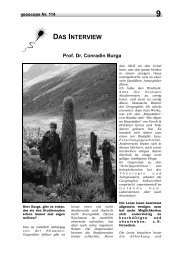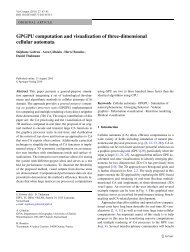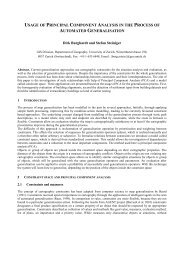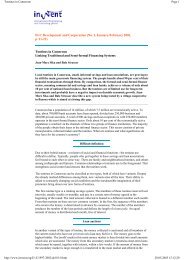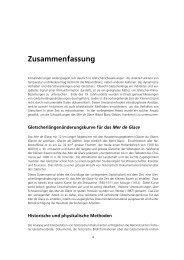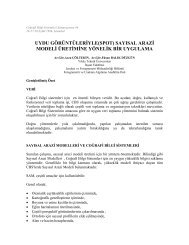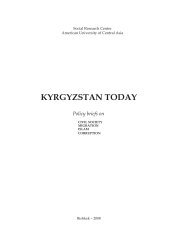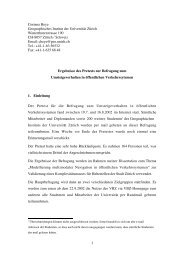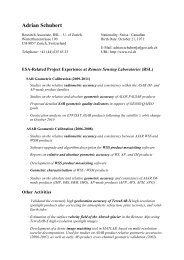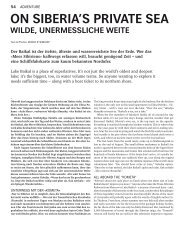Pedogenesis of Chernozems in Central Europe — A review
Pedogenesis of Chernozems in Central Europe — A review
Pedogenesis of Chernozems in Central Europe — A review
Create successful ePaper yourself
Turn your PDF publications into a flip-book with our unique Google optimized e-Paper software.
the Early Neolithic Period (5500–5000 BC). Thus, Chernozem<br />
formation should have been completed before 5500 BC<br />
(Schalich, 1981). It was assumed that the first Neolithic settlers<br />
(L<strong>in</strong>ienbandkeramik, 5500–5000 BC) found the <strong>Central</strong> <strong>Europe</strong>an<br />
loess areas covered with <strong>Chernozems</strong> that provided a basis<br />
for the <strong>in</strong>stitution <strong>of</strong> agriculture (Bogucki, 1988; Lün<strong>in</strong>g, 2000).<br />
Black humic horizons under a layer <strong>of</strong> Laacher See Tephra,<br />
the volcanic outburst was dated 12,900 cal. BP, were described<br />
by Roeschmann (1968) as remnants <strong>of</strong> <strong>Chernozems</strong> formed <strong>in</strong><br />
the Late Glacial, whereas Rohdenburg and Meyer (1968) denied<br />
the existence <strong>of</strong> fully-developed Late Glacial <strong>Chernozems</strong> <strong>in</strong><br />
favour <strong>of</strong> Calcaric Regosols with less pr<strong>of</strong>ound humic horizons.<br />
Rohdenburg (1978) suggested that a later pedogenesis <strong>in</strong> the<br />
Early Holocene could have affected the substrate under the th<strong>in</strong><br />
layer <strong>of</strong> Laacher See Tephra, lead<strong>in</strong>g to a mis<strong>in</strong>terpretation <strong>of</strong><br />
the humic horizons found under the ash layer. Also Altermann<br />
and Mania (1968) exam<strong>in</strong>ed soils buried under Laacher See<br />
Tephra and concluded that the formation <strong>of</strong> <strong>Chernozems</strong> started<br />
<strong>in</strong> the Younger Dryas. The authors identified the exam<strong>in</strong>ed<br />
horizon as part <strong>of</strong> an early Chernozem because <strong>of</strong> high grey<br />
humic acid concentrations. Reconsider<strong>in</strong>g the pr<strong>of</strong>ile descriptions,<br />
it could be stated that the fossil A horizon <strong>in</strong> the pr<strong>of</strong>ile<br />
We<strong>in</strong>berg near Schadeleben was only 12 cm thick, did not show<br />
any homogeneous humus distribution and had a relatively low<br />
carbon content <strong>of</strong> 3.4 g kg − 1 . In contrast, the Chernozem<br />
described at Salziger See developed <strong>in</strong> Atlantic. However, the A<br />
horizon is still less than 40 cm mighty and it is situated on<br />
material with gleyic properties. Still, there are no h<strong>in</strong>ts for<br />
pr<strong>of</strong>ound humic horizons under Laacher See Tephra and<br />
therefore <strong>in</strong> Late Glacial (Ik<strong>in</strong>ger, 1996).<br />
Most authors and textbook knowledge preferred the Early<br />
Holocene as time <strong>of</strong> Chernozem formation (Czerny, 1965; Rau,<br />
1968; Roeschmann et al., 1982; Scheffer/Schachtschabel,<br />
2002), based on the research <strong>of</strong> Laatsch (1934). He assumed<br />
that <strong>Chernozems</strong> formed <strong>in</strong> Boreal to Sub-Boreal, ma<strong>in</strong>ly <strong>in</strong><br />
Atlantic (c. 7800–5700 BP). His ma<strong>in</strong> argument was that<br />
merely more favourable climatic conditions than <strong>in</strong> Last Glacial<br />
would yield enough plant biomass to form the pr<strong>of</strong>ound mollic<br />
horizons, i.e. a warm and moist spr<strong>in</strong>g to enhance plant growth<br />
alternat<strong>in</strong>g with dry hot summers and cold w<strong>in</strong>ters when<br />
decomposition processes were halted.<br />
4.2. Radiocarbon dat<strong>in</strong>g<br />
When us<strong>in</strong>g the radiocarbon method, reliable material for<br />
dat<strong>in</strong>g would be charcoal or wood particles separated from soils.<br />
Measur<strong>in</strong>g extracted humic acids does not yield absolute ages,<br />
but the apparent mean residence time <strong>of</strong> soil organic matter,<br />
which is a m<strong>in</strong>imum estimate <strong>of</strong> soil ages. It is not possible to<br />
compare these ages to each other or relate them to certa<strong>in</strong> time<br />
periods (Geyh, 1983; Scharpenseel and Becker-Heidmann,<br />
1992).<br />
Radiocarbon dat<strong>in</strong>g has, s<strong>in</strong>ce the 1960s, been used to<br />
determ<strong>in</strong>e the ages <strong>of</strong> <strong>Central</strong> <strong>Europe</strong>an <strong>Chernozems</strong> and<br />
Phaeozems. Scharpenseel and coworkers dated a large number<br />
<strong>of</strong> soil samples (Scharpenseel and Pietig, 1969; Scharpenseel<br />
et al., 1996) but until now, a precise date <strong>of</strong> Chernozem forma-<br />
E. Eckmeier et al. / Geoderma 139 (2007) 288–299<br />
tion could not be confirmed. To determ<strong>in</strong>e ages for <strong>Chernozems</strong>,<br />
Scharpenseel and Pietig (1969) dated the soil organic<br />
matter (extracted humic acids) <strong>of</strong> a Chernozem A horizon<br />
covered by Laacher See Tephra, which therefore was regarded<br />
as be<strong>in</strong>g formed <strong>in</strong> the Late Glacial. A sample taken from<br />
material undisturbed by roots was dated 10,580±80 BP (sample<br />
‘Michelsberg II’). The authors concluded that the ‘Michelsberg<br />
II’ sample would give an absolute age and that <strong>Chernozems</strong><br />
could have formed <strong>in</strong> the Late Glacial, presumably s<strong>in</strong>ce<br />
Bøll<strong>in</strong>g (Scharpenseel and Pietig, 1969). On the other hand,<br />
Rohdenburg and Meyer (1968) disproved the existence <strong>of</strong><br />
pr<strong>of</strong>ound humic horizons <strong>in</strong> Late Glacial, and the age <strong>of</strong> the<br />
‘Michelsberg II’ sample would be the age <strong>of</strong> a Calcic Regosol,<br />
which could represent an <strong>in</strong>itial state <strong>of</strong> a Chernozem but not yet<br />
a fully developed one. Other measured maximum ages <strong>of</strong><br />
<strong>Chernozems</strong> and Phaeozems, the oldest ages measured <strong>in</strong> the<br />
deepest part <strong>of</strong> the soil pr<strong>of</strong>iles published by Scharpenseel et al.<br />
(1968), covered some thousands <strong>of</strong> years, from 5550 ±80 BP<br />
(4490-4260 BC) (sample ‘Söll<strong>in</strong>gen D’) to 2560±60 BP (810-<br />
540 BC) (sample ‘Wallertheim’). A black soil from Fehmarn<br />
(Baltic Sea) dates to the Middle Ages (1850 ±70 BP or 560-770<br />
AD) (sample Grossenbrode, Ostholsteen A).<br />
Until recently, black soil remnants <strong>in</strong> Early Neolithic (5500-<br />
5000 BC) settlements were classified as rema<strong>in</strong>s <strong>of</strong> <strong>Chernozems</strong>.<br />
However, most data published by Scharpenseel et al.<br />
(1996) revealed younger ages <strong>of</strong> these remnants, most <strong>of</strong> them<br />
related to the period 4500-2200 BC (Younger to End Neolithic).<br />
This was supported by AMS 14 C ages <strong>of</strong> charred organic<br />
material (black carbon) deriv<strong>in</strong>g from different German<br />
<strong>Chernozems</strong> (Schmidt et al., 2002). Unlike s<strong>in</strong>gle charcoal<br />
particles, black carbon data could give mean apparent ages <strong>of</strong><br />
fire events. The different ages could <strong>in</strong>dicate that <strong>Chernozems</strong><br />
formed over a longer time period then thought before (Gehrt<br />
et al., 2002; Schmidt et al., 2002).<br />
5. Vegetation <strong>—</strong> Formation under forests or after all still a<br />
steppe soil?<br />
Dokuchaev (1883, 1889) concluded that Russian <strong>Chernozems</strong><br />
formed under cont<strong>in</strong>ental climate and steppe vegetation.<br />
Earlier, it was assumed that they developed under moist and wet<br />
conditions like Stagnic or Gleyic <strong>Chernozems</strong> (WRB-FAO; Bell<br />
and McDaniel, 2000). Dokuchaev stated that the soil form<strong>in</strong>g<br />
factors <strong>in</strong>teract and that climate would not be the dom<strong>in</strong>at<strong>in</strong>g<br />
factor (Ehwald, 1984), and steppe vegetation was considered a<br />
ma<strong>in</strong> prerequisite for the formation <strong>of</strong> <strong>Chernozems</strong> (Laatsch,<br />
1934; Driessen et al., 2001). Thus, the recent <strong>Chernozems</strong> and<br />
Phaeozems <strong>in</strong> <strong>Central</strong> <strong>Europe</strong> were regarded as relics <strong>of</strong> former<br />
steppe climate and vegetation (Wilhelmy, 1950).<br />
Palynological evidence set the beg<strong>in</strong>n<strong>in</strong>g <strong>of</strong> reforestation <strong>in</strong><br />
<strong>Central</strong> <strong>Europe</strong> to the end <strong>of</strong> the Late Glacial (Firbas, 1949).<br />
The <strong>Central</strong> German dry region was covered with extensive<br />
forests s<strong>in</strong>ce approx. 9500 BP (Preboreal) (Lange, 1965; Litt,<br />
1992) and the Pannonian Bas<strong>in</strong> was covered with open forests<br />
s<strong>in</strong>ce Boreal (Hav<strong>in</strong>ga, 1972). Therefore, a formation <strong>of</strong> <strong>Central</strong><br />
<strong>Europe</strong>an <strong>Chernozems</strong> <strong>in</strong> the Early Holocene would not have<br />
occurred under steppe vegetation.<br />
293






